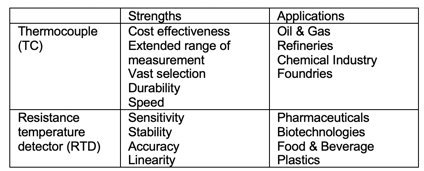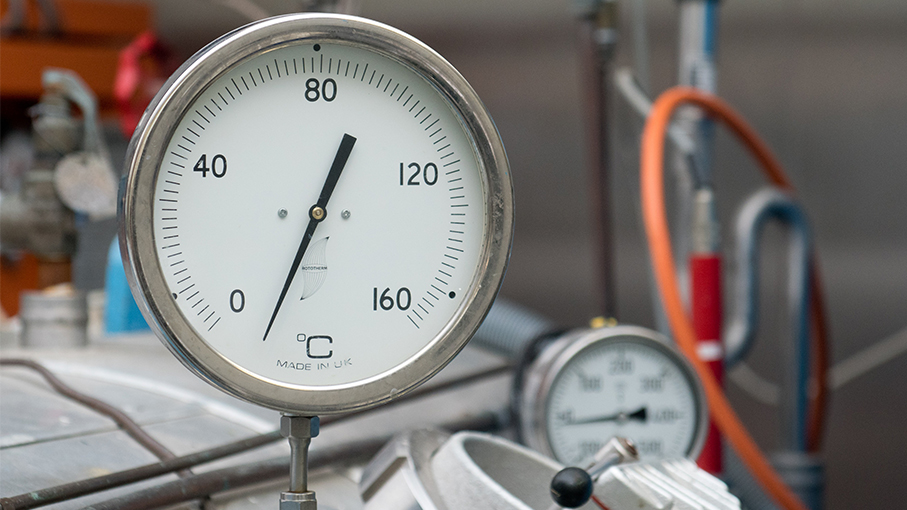Temperature measurement serves as the basis for many industrial parameters, such as process efficiency and energy consumption, resource optimization, and the life of plant and equipment.
In a great many industrial applications, there is a need to use a wide range of equipment to monitor, control and regulate temperature in a manner that is reliable, accurate and repeatable. Devices to measure temperature may be divided into contact and non-contact sensors and transducers. Contact temperature measurement devices include some of the most common device types: resistance thermometers, thermocouples, thermistors, integrated sensors, thermopiles, bimetallic-strip thermometers, and other devices. Non-contact sensors include pyrometers, thermal-imaging cameras, and infrared sensors. These instruments are used to measure objects (or materials) that are moving or inaccessible, or have low levels of heat conductivity, low thermal capacity, or high temperatures. Fields and limitations of use are, of course, closely linked to the measuring technique used.
Thermocouples and resistance thermometers, however, are the most used temperature sensors in industrial applications. As a result, there are a great many regulators, data loggers, data acquisition modules, converter repeaters, and signal transmitters in these two sensor categories. G.M. International has various models in our Series D1000 (D1072S, D1072D, D1073S), D2000M (D2010M, D2011M), D5000 (D5072S, D5273S), and D6000 (D6072S, D6273S).

Tab. 1 TC–RTD compared
Thermocouples
Thermocouples are among the most used temperature sensors because they are cost effective, standardized and suitable for a wide range of temperatures, and can be easily replaced. Their main limitation is accuracy, in that systematic errors of less than one degree Celsius are difficult to achieve. Thermocouples are also non-linear devices.
The principle underlying the thermocouple was discovered in 1821 by an Estonian scientist, Thomas Johann Seebeck, who found that a circuit made of two conductors of different natures produces a difference in potential when subjected to a temperature gradient. It is this phenomenon, known as the Seebeck effect, that enables thermocouples to function.
Various types of metal (nickel, chromium, iron, copper, platinum, tungsten, silicon, aluminum, rhenium) may be used to make a thermocouple, but for professional and industrial applications the choice of metal is based on long-standing regulations and standards (IEC EN 60584-1, ITS90), which make it possible to predict the voltages generated by the thermocouples and to operate with a wide range of temperatures. Unfortunately, it is not possible to connect a voltmeter to a thermocouple to measure the voltage, because this contact would inevitably generate another spurious junction. In order to measure with a certain degree of accuracy, this effect is accounted for using a technique known as cold-junction compensation (CJC). This technique is based on the principle that a third metal inserted between the two dissimilar metals of the junction of a thermocouple has no effect, given that the two junctions are at the same temperature (the law of intermediate metals).
There is a wide variety of sensors available for myriad industrial, medical, scientific uses and more. When selecting a thermocouple, it is best to ensure that the connector is compatible with the measuring instrument. It is also necessary to consider the temperatures to be measured, the isolation, and the manufacturing characteristics of the sensor. All of these factors have an effect on measurement accuracy and reliability.
Resistance thermometers
Together with thermocouples, resistance thermometers, also known as resistance temperature detectors (RTDs), are another of the most common temperature sensors. An RTD is a transducer that takes advantage of the change in the resistance of metals as a function of temperature. It consists of elements with a temperature coefficient of resistance that is positive and of modest value.
RTDs are made with anti-inductive metals such as platinum, nickel, copper, etc. The correlation between resistance and temperature is given by a higher-order polynomial. In the case of platinum, the formula used is the Callendar–Van Dusen equation (corrected based on the IPTS-68 temperature scale):
R = R0 [1 + At + Bt2 + C ( t-100) t3],
where A, B and C are constants dependent on the properties of the platinum used to make the sensor and R0 is the resistance at the temperature of 0°C (equal to 100 Ω and 1000 Ω in the case of Pt100 and Pt1000 platinum RTDs, respectively).
Platinum RTDs provide superior performance in terms of accuracy, linearity of response, duration over time, and field of measurement. There are two categories: thin-film and wire-wound. Thin-film sensors are made by vacuum depositing an extremely thin layer of platinum on a ceramic substrate of just a few square millimeters in size. Wire-wound elements consist of a length of thin platinum wire wound around a ceramic or glass core.
Because resistance thermometers are a contact thermometer, the protective casing must be suited to the purpose and to the installation conditions. There are various types of RTDs that are generally fairly resistant to corrosives. They can measure a wide range of temperatures (although less than a thermocouple) and feature excellent linearity. The primary limitations of RTDs are their low degree of sensitivity, their cost, which can be high, the inability to be used for detailed measurements, the influence of contact resistances, and their sensitivity to impact and acceleration.


